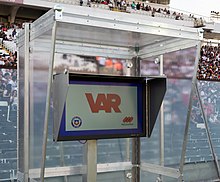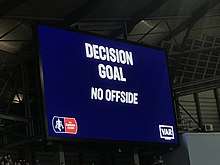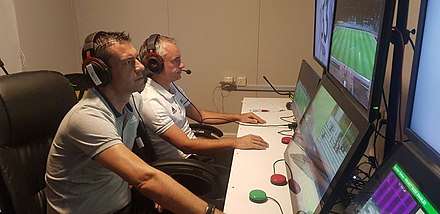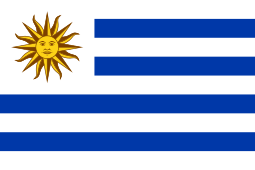Video assistant referee
The video assistant referee (VAR) is an assistant referee in association football who reviews decisions made by the head referee with the use of video footage and headset for communication.


Following extensive trialling in a number of major competitions, VAR was first written into the Laws of the Game by the International Football Association Board (IFAB) in 2018.[1] Operating under the philosophy of "minimal interference, maximum benefit",[2][3] the VAR system seeks to provide a way for "clear and obvious errors" and "serious missed incidents" to be corrected.[4]
Procedure
There are four categories of decisions that can be reviewed:[4]
- Goal/no goal – attacking team commits an offence, ball out of play, ball entering goal, offside, handball, offences and encroachment during penalty kicks.
- Penalty/no penalty – attacking team commits an offence, ball out of play, location of offence, incorrect awarding, offence not penalised.
- Straight red card – denial of obvious goal-scoring opportunity, serious foul play, violent conduct/biting/spitting, using offensive/insulting/abusive language or gestures. All straight red cards are subject to review.
- Mistaken identity in awarding a red or yellow card.
Check

The VAR team, stationed in the video operation room (VOR), automatically checks every on-field referee decision falling under the four reviewable categories. If the VAR does not identify any mistake during the check, this is communicated to the referee. This is called a "silent check" and requires no further action, usually not causing any delay to the game. At other times, a VAR check may cause the game to be delayed while the VAR ascertains whether or not a possible mistake has occurred. The referee may delay the restart of play for this to occur, and indicates an ongoing check by pointing to their ear.
Where the VAR does identify a possible clear and obvious error, there are three possible scenarios:
- Decision overturned on advice of VAR
- On-field review (OFR) recommended
- Referee chooses to ignore VAR advice
A decision can generally be overturned without an OFR where it relates to a factual matter. For example, offside decisions or whether a foul occurred inside or outside the penalty area can be determined by the VAR to the referee without a review. An OFR is generally recommended where there is a subjective decision to make, such as whether a foul was committed in the first place or whether a red card is warranted for a certain offence. In all cases, the final decision rests with the referee, and they can choose to ignore the advice of the VAR altogether.
On-field review (OFR)

An OFR can only be conducted on the recommendation of the VAR. This ensures that the referee always makes an on-field ruling and does not rely on OFRs for every close decision. An OFR can be conducted when the ball is out of play, or where the referee stops play for the express purpose of conducting one.
The referee signals an OFR by making the outline of a rectangle, indicating a video screen. The OFR takes place in a designated referee review area (RRA), adjacent to the field of play and in public view to ensure transparency. Slow motion replays are only used to establish point of contact for physical offences and handball, while full-speed replays are shown to determine the intensity of an offence or whether a handball occurred in the first place. During an OFR, the VAR transmits several video replays from different camera angles to allow the referee to make their decision.
Once an OFR is completed, the referee makes the TV signal again, before indicating the decision made. If the ball was out of play, it restarts with either the original decision or the new decision if the on-field one was changed. If play was stopped to conduct an OFR and the decision was not changed, a dropped ball occurs.
Offences
A number of offences relating to the VAR process are codified within the Laws of the Game. Both players and team officials excessively making the TV signal are cautioned. Any player or team official entering the RRA are also cautioned. Finally, entering the VOR will cause a player or team official to be sent off.
Assistant video assistant referee

The assistant video assistant referee (AVAR) is a current or former referee appointed to assist the VAR in the video operation room. The responsibilities of the AVAR include watching the live action on the field while the VAR is undertaking a "check" or a "review", to keep a record of reviewable incidents, and to communicate the outcome of a review to broadcasters.[4]
Glossary
A number of technical terms and abbreviations are used in reference to the VAR system. These include:
- Check – Process by which the VAR automatically inspects all reviewable decisions.[5] A check can result in confirmation of the on-field decision (a "silent check"), a change in decision for factual matters (e.g. offside/not offside) or the recommendation of an OFR.
- Clear and obvious error – Degree required for an on-field decision to be overturned.[6]
- OFR – On-field review; review process that occurs following recommendation by the VAR. Used where a clear and obvious mistake may have been made in regards to a subjective decision.
- RO – Replay operator; non-referee official who assists video officials by managing the broadcast and finding the best angles to allow for the right decision to be made
- RRA – Referee review area; area where an OFR is conducted, located adjacent to the field of play and in sight at all times
- VAR – Video Assistant Referee; main video official whose main role is to check all reviewable incidents and recommend an OFR where a possible clear and obvious error has occurred. The VAR is a current or former qualified referee.
- Video official – Category of match official, alongside on-field officials. Consists of VAR and any AVARs.
- VOR – Video operation room; room where the VAR team is located. The VOR can be located in or near the stadium, or in a centralised location such as a broadcast centre.
History
VAR was conceived by the Refereeing 2.0 project in the early 2010s, under the direction of the Royal Netherlands Football Association (KNVB).[7] The system was tested through mock trials during the 2012–13 season of the Eredivisie, the country's top football league. In 2014, the KNVB petitioned the International Football Association Board (IFAB) to amend its laws of the games to allow the system to be used during more extensive trials. The IFAB approved trials and a pathway to full implementation during its 2016 general meeting.[7][8] Lukas Brud, IFAB secretary, said "With all the 4G and Wi-Fi in stadia today...we knew we had to protect referees from making mistakes that everyone can see immediately", such as Thierry Henry’s handball that eliminated Ireland from qualifying for the 2010 FIFA World Cup where the on-field referees were not in a position to view the infraction. Then-FIFA president Sepp Blatter, who was strongly against introducing new technology in football, was forced out of his post due to a corruption scandal in 2015, and the VAR proposal received a warm reception under his successor Gianni Infantino.[7]
The first live trial of the VAR system was in July 2016 in a friendly match between PSV and FC Eindhoven[9]
The next live trial of the VAR system began in August 2016 with a United Soccer League match between two Major League Soccer reserve sides.[10] Match referee Ismail Elfath reviewed two fouls during the match and, after consultation with video assistant referee Allen Chapman, decided to issue a red card and a yellow card in the respective incidents.[11]
Video reviews were introduced the following month during an international friendly between France and Italy.[12]
The first professional "non-friendly" game was an official first round KNVB beker national Cup tie between Ajax and Willem II on 22 September 2016. [13]. This match was the first match to include a "pitchside monitor". The pitchside monitor would allow the referee to review footage from the field. Based on VAR but not using the available pitchside monitor, a yellow card was turned into a red card and thus this was the first ever VAR based expulsion in a professional game.[14] Interestingly, this professional and official Cup game was played before the official FIFA rule change. The major learning from this decision is that VAR decision needed to be clearly communicated to the player, the watching public inside the stadium and on TV.[14]
The next event that VAR was used, including a "pitchside monitor" was at the 2016 FIFA Club World Cup. [15]
Others also falsely claimed to be first with VAR[16] [17]
Major League Soccer in the United States introduced VARs in competitive matches during its 2017 season after the 2017 MLS All-Star Game on 2 August 2017.[18][19] Its first official use came during a match between the Philadelphia Union and FC Dallas, invalidating a goal from the latter over contact made between a Dallas player and Philadelphia's goalkeeper.[20] VAR was used at an international level in the 2017 FIFA Confederations Cup in June, where it was praised but its usefulness was questioned after a referee decision in the final match.[21][22]
After the 2016 introduction in CUP football in Europe, the VAR system was introduced in top flight European football league competitions by Bundesliga and the Serie A at the beginning of the 2017–18 season[23] and by La Liga at the beginning of the 2018–19 season.[24] The system was also used at the 2017 FIFA U-20 World Cup in October.[25] On 8 January 2018, VAR was trialled for the first time in England in the 2017–18 FA Cup game between Brighton & Hove Albion and Crystal Palace,[26] and the following day it was trialled for the first time in France in the Côte d'Azur derby game in the 2017–18 French League Cup. It was said to have worked well.[27]
Italy opened the world's first VAR training centre in Coverciano in January 2018.[28]
On 3 March 2018, the IFAB wrote the VARs into the Laws of the Game on a permanent basis. [29] Their use remains optional for competitions, and the English Premier League and the UEFA Champions League were not expected to implement VAR for their 2018–19 season.[30] However Premier League executive chairman Richard Scudamore has described it as "inevitable" that VAR will be introduced to the Premier League.[31] On 27 September 2018, UEFA announced that from the 2019–20 UEFA Champions League season, VARs will be used in the competition.[32] Although VAR was not implemented in the group stages of the 2018–19 season, UEFA announced on 3 December 2018, that VAR would be used in the knockout stages, which commenced in February 2019.[33]
On 15 November 2018, Premier League teams voted in principle to bring Video Assistant Referees to the Premier League from the 2019–20 season onwards pending approval of IFAB and FIFA; this comes after a controversial decision from referee Simon Hooper to disallow a goal scored by Southampton F.C. striker Charlie Austin.[34]
2018 FIFA World Cup
FIFA officially approved the use of VAR for the 2018 FIFA World Cup during the FIFA Council meeting on 16 March 2018 in Bogotá.[35][30][36][37] This tournament became the first competition to use VAR in full (at all matches and in all venues).[38]

The 2018 World Cup marked the system's World Cup debut. A total of 335 incidents were checked by the VAR over the course of the group stage, averaging seven per match, and fourteen calls made by referees were changed or overruled after being reviewed by the VAR. According to FIFA, the VAR system had a success rate of 99.3 percent, up from the 95 percent of correct calls by referees without VAR.[39] The first VAR decision at the World Cup came on 16 June 2018 in a group stage match between France and Australia, where referee Andres Cunha awarded a penalty to France after consulting with the VAR.[40][41] In the final, referee Néstor Pitana used the VAR to review a defensive foul for handling in the penalty area, awarding France a penalty, which gave them a 2–1 lead over Croatia. The final eventually ended with France prevailing 4–2.[42]
The use of VAR has been credited with assisting the 2018 edition's status as the cleanest World Cup since 1986, after no red cards were issued in the opening 11 games and only four players were sent off in the entire tournament which was the fewest since 1978.[43] 22 goals were scored from 29 awarded penalty kicks, beating the previous record of 17 penalty kick goals set in the 1998 tournament; the dramatic increase in the number of penalties awarded at the 2018 World Cup has been attributed to VAR catching fouls which would otherwise have remained unpunished.[44] IFAB technical director and former Premier League referee David Elleray stated a belief that the presence of VAR meant that players would know that they would not be able to get away with anything under the new system.[45]
Criticism
The use of video technology at the 2017 FIFA Confederations Cup was criticised after several contentious moments involving VAR at the tournament. It was accused of "creating as much confusion as clarity".[46][47]
Further criticism was leveled at VAR after it suffered issues preventing its use, for example in a Portuguese match where a supporter's flag had been obscuring the VAR camera,[48][49] or in the 2018 A-League Grand Final between Newcastle Jets and Melbourne Victory where the VAR software suffered a technical malfunction which prevented the assistant referee from viewing the replay.[50][51]
After the introduction of VAR in the 2018 World Cup, FIFA deemed it a success. Nevertheless, the use (or lack of use) of VAR has been criticised.[52][53] Independent assessments note that while most decisions were made correctly as a result of VAR, some were wrong despite VAR review and some decisions which were called incorrectly were not even reviewed.[54][52] The Guardian concludes that VAR has been most effective for factual decisions such as offsides and mistaken identities, while subjective decisions such as penalties or the disciplining of players have fared much worse. Lack of clarity and consistency are two main areas of weakness.[55]
Another line of criticism has been targeted at the effectiveness of the system in achieving its goal. In the opinion of Scott Stinson from the National Post, VAR, like any other replay system, fails to correct human error and instead only adds to the controversies because human judgment is still necessary.[56] Lack of transparency is another contentious point, as teams have no way to know which incidents were reviewed by the VAR team.[57] At a press conference held after the group stage, FIFA referees committee chairman Pierluigi Collina showed footage of the decision-making process accompanied with audio of the conversations between VAR officials and the referees. Asked if this audio could be made publicly available, as it is in rugby and cricket, Collina answered enthusiastically but cautioned that it might still be too early.[58][59]
Others have pointed to the game-changing nature of VAR. Initial fears that using the system would lengthen the game considerably have not been confirmed, with every VAR review taking up an average of only 80 seconds.[60] The dramatic increase in the number of penalties awarded at the 2018 World Cup has been attributed to VAR catching fouls which would otherwise have remained unpunished. Of the 169 goals scored in the tournament, 22 were from penalty kicks (with 29 being awarded in total), beating the previous record of 17 set in the 1998 FIFA World Cup.[44] Jonathan Liew of The Independent compares the situation to the introduction of the Decision Review System in cricket and notes the changes it had on that sport, and suggests that it might lead to changes of a similar nature in football.[61]
In February 2019, UEFA issued guidance which stated that players who made a 'TV-screen' hand gesture should result in a yellow card.[62] "Excessively using the 'review' (TV screen) signal" is now listed as a caution for which a player may receive a yellow card in the Laws of the Game.[63] Early uses of VAR in the Premier League, at the beginning of the 2019–20 season, were described as confusing to both coaches and fans with the decision making often inconsistent.[64]
Competitions using VAR
.jpg)
Competitions which include VAR confirmed matches are "live" matches, i.e. where the VARs have contact with the referee on the field of play and therefore may have an impact on the decision making.[65]
There is also an idea of implementing VAR in futsal matches[66]..
Club competitions
Domestic leagues

.svg.png)
.svg.png)






































.svg.png)


Domestic cups














Continental
National team competitions
Continental
See also
- Goal-line technology
- Instant replay – describes other sports using video referees.
Notes
- Semi-finals onwward only
- Starting in the 2020–21 season
- Play-off and play-out only[67]
- Finals only
- Knockout stages and the finals only
- Play-off rounds and competition proper only
- Knockout stages until finals only, group stages will be introduced in the 2021-22 season.
- Knock-out stage onward only
- Starting in 2021[79]
- Starting in 2021
- Final four only
References
- "Historic step for greater fairness in football". International Football Association Board. 3 March 2018. Retrieved 3 March 2018.
- "World Cup 2018: VAR helps tournament reach 10 penalties – so is it working?". BBC Sport. 20 June 2018 – via www.bbc.com.
- Staff, S. V. G. "EVS Xeebra Replay System Facilitates VAR Implementation for Copa do Brasil Tournament". Sports Video Group.
- "video assistant referees (vars) Protocol". International Football Association Board. 26 April 2017. Retrieved 26 April 2017.
- "Video Review: Answering all your Frequently Asked Questions". Major League Soccer. 2 August 2017. Retrieved 23 September 2019.
- "VAR: Willian 'dive', Iheanacho goal – how does the system work?". BBC Sport. 18 January 2018. Retrieved 17 July 2019.
- Medeiros, João (23 June 2018). "The inside story of how FIFA's controversial VAR system was born". Wired. Retrieved 30 June 2018.
- "Minutes of the 130th Annual General Meeting of the International Football Association Board". IFAB. pp. 13–17. Retrieved 3 March 2018.
- KNVB Media (20 December 2016). "HET JAAR VAN DE VIDEOSCHEIDSRECHTER (The Year of the Video Referee)". KNVB. Retrieved 11 March 2020.
- Alvarez, Liana (19 August 2016). "MLS makes soccer history with debut of video assistant referees". Sports Illustrated. Retrieved 19 December 2016.
- Williams, Bob (13 August 2016). "Video assistant referees edge closer after successful trial in United States". The Daily Telegraph. Retrieved 19 December 2016.
- Rumsby, Ben (2 September 2016). "Video replays used for first time during France's 3–1 friendly win over Italy as 'football history' made". The Daily Telegraph. Retrieved 19 December 2016.
- Reuters (22 September 2016). "Video replays: Referees to use pitch-side monitors at Fifa's Club World Cup". The Guardian. Retrieved 11 March 2020.
- "Highlights Ajax – Willem II (Min 3:00–4:00)". YouTube. 22 September 2016. Retrieved 11 March 2020.
- "Video replays: Referees to use pitch-side monitors at Fifa's Club World Cup". BBC Sport. 7 December 2016. Retrieved 19 December 2016.
- "Hyundai A-League first to use Video Assistant Referees". Hyundai A-League. Retrieved 26 April 2017.
- "Video Assistant Referee: Australia's A-League uses system during trial". BBC Sport. 8 April 2017. Retrieved 28 June 2018.
- Borg, Simon (10 December 2016). "MLS will seek to introduce Video Assistant Referees (VAR) during 2017". Major League Soccer. Retrieved 19 December 2016.
- Goldberg, Jamie (14 March 2017). "MLS leads the way among soccer leagues worldwide as it prepares to roll out video replay". The Oregonian. Retrieved 15 March 2017.
- "Video review debuts in MLS, rules out goal in Dallas' first-ever loss to Union". ESPN FC. 5 August 2017. Retrieved 6 August 2017.
- Ogden, Mark (2 July 2017). "VAR creates as much confusion as clarity in Confederations Cup final". ESPN. Retrieved 4 March 2018.
- "Russia 2017, VAR praised at closing press conference" (Press release). FIFA. 1 July 2017. Retrieved 4 March 2018.
- Kohli, Siddharth (17 August 2017). "VAR: The good, the bad and the ugly". CNN. Retrieved 4 March 2018.
- "LaLiga Santander: Tebas: With VAR, there will be more fairness in football – MARCA in English". MARCA in English. Retrieved 19 August 2018.
- "Football poised to change forever with the introduction of Video Assistant Referee system". The Independent. Independent Print Limited. 9 March 2017. Retrieved 27 June 2017.
- "FA Cup trial for Video Assistant Referee". RTÉ News. 7 December 2017 – via www.rte.ie.
- "Nice-Monaco: la vidéo "a très bien fonctionné"". Eurosport.fr. 10 January 2018. Retrieved 4 March 2018.
- "Italy host first VAR training centre". Football Italia. 19 December 2017. Retrieved 4 March 2018.
- "Historic step for greater fairness in football". The IFAB. IFAB. 3 March 2018. Retrieved 6 July 2018.
- Conway, Richard (3 March 2018). "VAR: Video assistant referees set to be used at 2018 World Cup in Russia". BBC. Retrieved 4 March 2018.
- "VAR in Premier League is inevitable, says Richard Scudamore". BBC Sport. 6 May 2018.
- "Champions League: VAR to be introduced in 2019–20 season". BBC Sport. 27 September 2018 – via www.bbc.co.uk.
- "VAR to be used in UEFA Champions League knockout phase". uefa.com. 3 December 2018.
- "VAR: Video assistant referees set to be used in Premier League next season". BBC Sport. 15 November 2018 – via www.bbc.co.uk.
- "IFAB comes to landmark decision about VAR". FIFA.com. Fédération Internationale de Football Association. 3 March 2018. Retrieved 3 March 2018.
- "VAR discussed at IFAB media briefing". FIFA.com. Fédération Internationale de Football Association. 3 March 2018. Retrieved 3 March 2018.
- "FIFA finally approves video review to use at World Cup". The Washington Post. 16 March 2018. Retrieved 16 March 2018.
- Medeiros, João. "The inside story of how FIFA's controversial VAR system was born". Retrieved 28 June 2018.
- "World Cup 2018: VAR system 'fine-tuned' after criticism". BBC Sport. 29 June 2018. Retrieved 30 June 2018.
- Grez, Matias (16 June 2018). "History made as VAR used for first time in World Cup match". CNN.com. Retrieved 30 June 2018.
- Johnson, Dale (16 June 2018). "How VAR made history with penalty for France". ESPN. Retrieved 16 June 2018.
- Taylor, Daniel (15 July 2018). "France seal second World Cup triumph with 4–2 win over brave Croatia". The Guardian. Retrieved 15 July 2018.
- "World Cup by the numbers – 169 goals, 29 penalties, 10 late winners, 4 red cards". ESPN. 16 July 2018. Retrieved 17 July 2018.
- Kirk, Ashley; Scott, Patrick (29 June 2018). "13 intriguing stats from World Cup 2018 so far". The Telegraph. Retrieved 4 July 2018.
- Rumsby, Ben (17 June 2018). "VAR effect results in cleanest World Cup since 1986 after no red cards are issued in opening 11 games". The Telegraph. Retrieved 17 July 2018.
- "Confederations Cup: Video assistant referee system 'a shambles'". BBC. 2 July 2017. Retrieved 9 March 2018.
- "VAR creates as much confusion as clarity in Confederations Cup final". ESPN. 2 July 2017. Retrieved 9 March 2018.
- Browne, PJ (7 February 2018). "Watch: Flag Waving Fan Causes VAR Chaos In Portugal". Balls.ie. Retrieved 4 March 2018.
- "VAR and the giant flag: how a match in Portugal became the scene of farce". The Guardian. 7 February 2018. Retrieved 4 March 2018.
- "A-League grand final: Victory's offside goal inaction due to VAR glitch, says FFA – ABC News (Australian Broadcasting Corporation)". mobile.abc.net.au. Retrieved 3 June 2018.
- "Wrongly awarded goal decides Aussie title after VAR failure". Arizona Daily Star. Retrieved 3 June 2018.
- Belam, Martin (22 June 2018). "VAR at the World Cup: the big decisions, game by game". The Guardian. Retrieved 4 July 2018.
- "So VAR, so good? Fifa praises review system in helping referees get '99.3% decisions correct'". ITV News. 29 June 2018. Retrieved 4 July 2018.
- Johnson, Dale. "VAR at the World Cup: A timeline of the tournament". ESPN.com. Retrieved 4 July 2018.
- Nakrani, Sachin (26 June 2018). "VAR: the World Cup verdict so far – some success but more clarity needed". The Guardian. Retrieved 4 July 2018.
- Stinson, Scott (26 June 2018). "'VAR is bulls—t': Video review's honeymoon phase comes to sudden, spectacular end at World Cup". National Post. Retrieved 4 July 2018.
All of a sudden, VAR had been revealed to be just like any other replay system: a process meant to reduce the number of controversies by correcting human error was now only adding to the controversies because there was still human judgment involved. And no replay could render that judgment infallible.
- "Brazil questions VAR procedures after 'clear errors by referee' in Swiss match". CBC. Associated Press. 18 June 2018. Retrieved 4 July 2018.
The confederation says it wants to know whether the plays were reviewed in any way, saying "transparency is of essence."
- Wood, Martyn (29 June 2018). "FIFA referees chief pleased but not surprised by VAR success at World Cup". IOL. Retrieved 4 July 2018.
- "RELIVE: Referee media briefing held after group stage". FIFA.com. 28 June 2018. Retrieved 4 July 2018.
- Sengupta, Ayon (2 July 2018). "Mixed response for VAR". The Hindu. Retrieved 4 July 2018.
- Liew, Jonathan (29 June 2018). "VAR is going to change football as we know it – but we have no idea if that's a good thing or not". The Independent. Retrieved 4 July 2018.
- "Video assistant referee: Uefa says 'TV gesture' a bookable offence". BBC Sport. 6 February 2019 – via www.bbc.co.uk.
- "Laws of The Game".
- "VAR in the spotlight after Premier League weekend of confusion". Sky Sports.
- "VIDEO ASSISTANT REFEREES (VARS) USED LIVE IN COMPETITIONS AND LEAGUES".
- "VAR in futsal: Unlikely or expected future?". futsallfeed.com. Retrieved 8 April 2020.
- "La Var è ufficiale anche in Serie B: si parte dal prossimo campionato". La Gazzetta dello Sport – Tutto il rosa della vita (in Italian).
- Krishnan, Joe (3 January 2020). "VAR to be used during FA Cup third round... but only at Premier League stadiums". The Evening Standard.
- Lindsay, Jessica (18 May 2019). "Will VAR be used in the 2019 FA Cup final?". Metro. DMG Media. Retrieved 18 May 2019.
- Keighley, Freddie (6 January 2020). "Carabao Cup: VAR to be used in semi-finals and final". The Independent. Retrieved 6 January 2020.
- Challies, Josh (30 July 2019). "VAR and new rules in effect for Man City v Liverpool FC in Community Shield". Manchester Evening News. Retrieved 30 July 2019.
- "Pokal ab Achtelfinale mit Video-Assistent" [Pokal from round of 16 with VAR]. German Football Association (in German). 7 August 2019. Retrieved 7 August 2019.
- "UFFICIALE – Coppa Italia cambia regolamento: arrivano sorteggio, VAR e la 4a sostituzione". Fantacalcio.it – Solo il meglio del calcio. 7 October 2018.
- https://www.tuttomercatoweb.com/serie-a/supercoppa-italiana-l-arbitro-sara-banti-al-var-c-e-guida-1201717
- "¿Hay VAR en la Copa del Rey 2019–20?". Goal.com (in Spanish). 22 January 2020.
- https://www.sportfair.it/2019/04/conmebol-var-societa-britannica-fornitrice/907816/
- Félix Díaz, José (9 July 2020). "No habrá VAR en la fase de grupos de la Europa League 2020-2021". Marca (in Spanish).
- https://it.uefa.com/womenschampionsleague/news/0255-0e1786afb45f-8f45a6059875-1000--var-per-la-finale-di-women-s-champions-league-e-women-s-euro-20/
- Tom Marshall (7 July 2019). "2021 Gold Cup to be mainly in U.S., feature VAR". ESPN.
- "Il VAR in azione dagli ottavi di UEFA Champions League | La UEFA". UEFA (in Italian). 11 February 2019.
